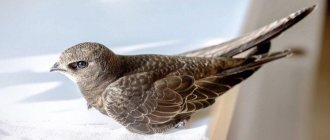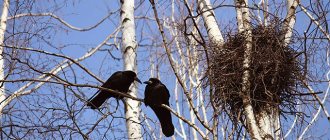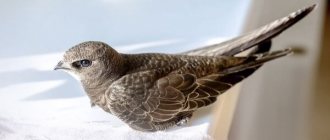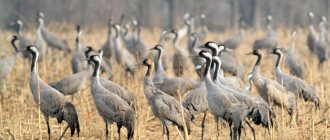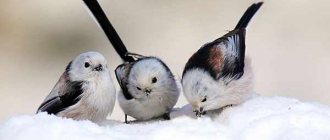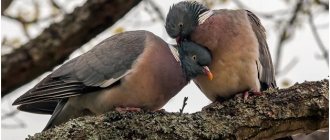Swift's feet
The swift's legs are also brown, but lighter than the plumage, and the eyes, on the contrary, are darker.
The black swift's toes are also one of its distinctive features. All four toes of each paw “look” forward, whereas in most birds one is opposed to the rest for balance or the ability to cling to tree branches.
The swift is only able to cling to steep surfaces; it can crawl along walls, but cannot walk or jump on the ground. If swifts land on the ground, they are in great danger: due to the fact that their legs are too short, the birds are deprived of the ability to push off and take off, they need a hill that allows them to “lie down” on their wings, catching the wind.
For the same reason, when flying onto the balconies of townspeople (which happens rarely, but still happens), the swift cannot fly away on its own: high railings do not allow it to do this, and on the floor it can only crawl, leaning on its wings.
Habitats and lifestyle
This species of bird makes migratory flights. In the summer, they settle in large numbers in Western Siberia, China and so on to Spain. In the northern part of the planet, swifts choose Finland, Norway and the subarctic zones of Russia as nesting places. Black swifts breed their offspring in the southern territories:
- Algeria;
- Israel;
- Lebanon;
- Morocco:
- Near East.
Birds winter in southern Africa, as well as on the equator. They live most comfortably there. Swifts feel best when in flight. They always fly rapidly, and to turn they make a large turn . A distinctive feature of black swifts is the fact that while in flight the bird can:
- There is;
- mate;
- sleep.
There is no other bird in the world that can do this.
They can spend 2-4 years in the air without landing on the ground. During the nesting season, they are forced to build nests for breeding. Basically, these birds live in flocks and always nest in colonies. Swifts have 4 toes on their paws, pointing to the side, so it is difficult for them to maintain balance while sitting on the surface of the ground. They cannot move - jump, walk on their paws. For this reason, swifts are always in flight to protect themselves. It is believed that these birds are the fastest, since their flight speed reaches 120 km/h , and swallows can reach a maximum speed of 60 km/h. Swifts are always active from morning until evening. Their lifespan is about 20 years.
Nutrition
In inclement weather, when insects hide from the rain, a hungry time comes for swifts. But nature has endowed swift chicks with an amazing ability - to fall into torpor. In this state, they do not need food, and the parents have the opportunity to go in search of more favorable places for hunting. They can fly away over fairly long distances and spend up to fifteen days hunting.
Another feature of the black swift is its ability to reach flight speeds exceeding the speed of an airplane. This bird is the most reactive among Russian birds and is only ahead of the falcon in the speed of its fall.
Swift: description
Residents of cities and villages literally meet these birds every day, if they do not fly to warmer climes to spend the winter. Residents of some countries nicknamed these birds “feathered nimble birds.” It should be noted that swifts are unusual birds, representing an entire family that includes more than 16 species. Despite some similarities with swallows, swifts do not have any family ties with swallows, since swallows represent the passerine family. If you look closely, you can find visual differences: swifts have large wings, therefore, in flight, they make fewer movements. In addition, swallows have somewhat longer limbs, which allows them to take off from a flat surface and land on it without any problems.
Interesting to know! Swifts in flight demonstrate real aerobatics. This maneuverability is associated with the ability to regulate the frequency of wing flapping, independently of one another. As a result of the difference in the flapping frequency of the left and right wings, swifts perform instantaneous maneuvers without changing their flight speed. As a result, they catch up with insects in flight and carry out a roundhouse attack.
Swifts are small birds that fly at speeds of up to 170 km/h. If we compare swifts with swallows, then their flight speed is 2 times greater than that of swallows. The wing structure of swifts is simply unique, and excellent flight characteristics allow them to stay in the sky for up to 6 months without rest. Often, while in the sky, swifts mate, which in itself is a unique event.
Kings of the sky. Black swifts (Apus apus).
Appearance
Adult birds grow up to 10-25 cm, depending on the species, while their weight ranges from 50-185 grams, which also depends on the species. Swifts have a relatively large head and dark eyes. The wings are curved and relatively long, and the tail is forked, straight and long.
Despite the fact that the wings are powerful, the limbs of swifts are short and weak. The fingers are also short, but the claws are long and point forward. This structure of the limbs causes some problems due to the fact that it is inconvenient for swifts to take off from a flat surface. And yet, this structure allows birds to cling even to the ledges of steep rocks.
The main color of the plumage is not considered attractive and is made in shades of gray and black, although there are swifts with a white belt. The same feathers, white, are present in the chest area, within the undertail, in the neck area and on the head. It is not possible to determine by appearance whether it is a female or a male, since males and females have no external differences. The most common species is considered to be black swifts, although populations of white-striped swifts living in the eastern regions are considered very numerous. A similar situation is observed in a number of other countries. You can often see swifts whistling and darting around city parks at high speed. Apart from their basic color, depending on the species, the family of swifts has a similar body structure, as well as a similar behavior pattern.
Character and lifestyle
Swifts represent the order of swift-like animals, and about 8 dozen species belonging to this order live on our Planet. Among the representatives of the order there are both sedentary and migratory species. Swifts prefer to nest in numerous colonies, although sometimes they live in small groups. Each colony can number several hundred individuals. These birds are active from early morning until late evening.
In the past, swifts preferred to nest in the hollows of tall trees. They still arrange their nests in this way today, living in Scotland, as well as Aberna Forest. Nowadays, swifts mainly nest under the roofs of old buildings, for which they often pay with their lives, since old buildings are often demolished. They build their nests thanks to the presence of a special salivary gland, which produces a sufficient amount of building material in the form of mucus. This mucus connects all building components quite firmly.
How long does a swift live?
Living in their natural environment, the lifespan of swifts is about 5 and a half years.
Types of swifts
Dozens of species of these unique birds live in nature, with the black swift considered the most common. This is the only representative of a large family that is capable of taking off from a flat surface. To take off, the bird jumps to a small height, which allows it to make the first flap of its wings, which is enough for further flight. The singing of a swift can be compared to subtle music.
Interesting information! Whiskered swifts grow up to 30 cm in length, or even more, so they are the largest representatives of this family. This type of swift prefers to live in the mountains, at altitudes up to one and a half thousand meters above sea level. Its head is adorned with long, attractive mustaches, while the eyebrow is characterized by a white color.
Needle-tailed swifts grow up to 22 cm in length, with a wingspan reaching half a meter, and weighing up to 180 grams. The upper body is light brown while the lower body is darker.
The wings are black with a metallic tint, while the head and throat area are almost white. They prefer to nest within forested areas, making their nests in tree hollows. The female lays from 3 to 6 eggs.
Habitat
Swifts winter in areas located south of the Sahara Desert. Birds ringed in Britain have been found in the Congo Basin, Malawi, Tanzania and Zimbabwe, as well as Mozambique and southern Africa. Scientists still do not have reliable information about the flight routes of these birds.
What do they eat?
Swifts are birds whose nutrition depends on weather conditions. Prolonged fasting, which leads to a decrease in body temperature, is unacceptable for them. You can often see swifts seeming to be in a state of stupor. The agility of these birds in the air is simply off the charts. With their beak, like a net, they catch various insects in flight. These are the only birds capable of taking prey even from a falcon.
If food is insufficient due to weather conditions, swifts hibernate for 2 to 10 days to survive the bad weather. Surprisingly, not only adult birds, but also chicks can hibernate.
The chicks can sleep for a whole week, with their parents leaving the nest from time to time in search of food if weather conditions allow this. Somewhere in August, these birds go to warmer climes for the winter, but in any case, much depends on the availability of food, as well as on weather conditions. In search of food, swifts can leave their native places for a long time, but then they always return back.
Reproduction and offspring
These birds are found both in large and small cities, in rural areas, and in forests, in the mountains, and also in deserts. Birds can nest in various conditions, since they can arrange nests for themselves in trees, in tree hollows, under the roofs of houses, and also in earthen burrows.
The bird builds a nest from various available materials that are available to birds in specific habitat conditions. Despite this fact, swifts do not collect leaves, sticks, dirt and other components from the ground, as other birds do.
Building materials consist of those elements that swifts can catch on the fly. These are thin fibers of various origins, feathers and down, etc. The couple completes the construction of the nest in about a week. Every year these birds return to the nest that they have built themselves.
Important fact! Swifts choose their soul mate once and for life. Considering the fact that these birds spend most of their lives in the air, they can mate in the air.
Having laid eggs, which are characterized by a white color, the female sits on them and incubates them for 3 weeks. During this period, the male obtains food not only for himself, but also for the expectant mother.
The duration of incubation largely depends on weather conditions, which affect the male’s production of food. After birth, the chicks stay close to their parents for almost a month and a half, which also depends on weather conditions that affect the process of growth and development of the chicks.
Natural enemies
Regardless of species, swifts do not have many natural enemies. The most formidable predator for swifts is the hobby. Often the greatest danger to these birds is humans, and this is not at all surprising, since they are introduced into the living space of many inhabitants of the natural environment.
In southern Europe, local residents believe that the meat of young swifts has not only excellent taste, but also beneficial qualities. Because of this, people hunt these birds by setting various traps.
Important point! The traps are arranged in such a way that you can get inside at any time. Birds, unsuspectingly, lay eggs in these traps and hatch their chicks. When the chicks become almost adults and are ready to leave the trap nest, people take them and eat them.
Many birds of prey cannot catch swifts in flight, since they fly quickly and do not fall close to the surface of the earth. These birds risk their lives during seasonal migrations, as well as moving to other territories in search of food.
Often, various rodents visit swift nests and destroy them. This is especially true when swifts build nests in accessible places. Setting up their nests under the roofs of old buildings, they lose their nests because people get rid of old buildings, and when they return after wintering, they die from the cold without finding their nests.
Chicks
Swifts hatch two or three eggs at a time. Both the female and the male incubate them for fourteen days. This time varies depending on the weather and therefore the ability to hunt. In the event of completely unfavorable weather conditions, parents may abandon the nest, losing the opportunity to breed offspring this year.
Grown-up chicks fly out of the nest a month after birth, but if the weather is not favorable, they may linger for two. As soon as the young leave the nest, they begin an independent life.
Reproduction and lifespan
Puberty of these birds is observed after the first year of life. They become parents after 3 years of life. They actively reproduce for two years after this. The male looks for his female right in the air. Mating takes place there and only after this the birds begin nesting.
To do this, they choose places in the rocks and on the banks. City swifts are comfortable nesting under balconies or roofs. It costs these bullies nothing to drive smaller birds away from their nest.
An important condition when building nests is the height; they should be located at least 3 meters. After the nest is ready, females lay 2-3 eggs in it. Hatching them lasts 16-22 days. Cold conditions may increase timing.
The chicks appear one after another at intervals of a day. The firstborn is considered the hardiest. The rest do not always cope with weather conditions and die. Both parents feed the ever-hungry chicks. After 40 days of life, the chicks become independent. Birds live 20 years.
What bird makes nests in burrows?
Earthen nests in burrows are made by shore swallows, kingfishers and firecrackers. Colonies of shore swallows are located, as a rule, on open, steep river banks well warmed by the sun. At the same time, swallows avoid places with purely sandy and clayey soil.
Interesting materials:
How does a fish swim? How are fish adapted to their habitat? How to skin a scaleless fish? How to save caught fish while fishing? How to store salted fish in the freezer? How to keep fish fresh when fishing? How to preserve fresh fish in nature? How to preserve frozen fish? How to salt fresh frozen fish? How to dry fish in the cold in winter?
How many years do swifts and swallows live?
The lifespan of swifts, according to some data, can reach about 15-20 years. However, it is argued that the conditions in which swifts exist are very harsh, so it is a rare bird that survives to such an age. At home, according to some reviews, swifts can live 8 years or even longer.
Interesting materials:
Where are all WhatsApp audios stored on iPhone? Where are all Windows 10 passwords stored? Where are bookmarks stored on a computer? Where are bookmarks stored in Windows 10? Where are fresh water reserves stored? Where was food stored when there were no refrigerators? Where to store bananas in an apartment? Where to store yeast pies? Where to store photos without losing quality? Where can I store photos on my computer?
Interesting facts about swifts
During the time that ornithologists have been observing these special birds, several interesting facts about them have been revealed.
The black swift catches insects with its beak in flight. The structure of the jaw allows you to put up to 1000 insects into your mouth at a time.
Swift chicks eat a lot. During their growth, an adult individual brings about 40 thousand insects each. To deliver so much food, he has to make 30-40 search flights. In total, the distance over which the swift flies during the search reaches 40 thousand kilometers.
10 weeks after birth, the chicks are able to feed and fly independently. They rise up to a height of 2000 meters and remain there until they grow up. Swifts sleep only in flight, waking up every 10 seconds to flap their wings.
An unpleasant fact! In the late 19th century, people hunted swifts' eggs and nests because their meat was believed to have healing properties. Hunting has brought the birds to the brink of extinction.
Natural enemies
Swifts do not have many natural enemies. This affects all species of swifts on the planet. The main dangerous enemy and adversary is the Hobby bird of prey. Sometimes the enemy of defenseless birds is man himself.
For example, such a situation is developing in the south of European countries. It is generally accepted there that the flesh of young birds of this species has wonderful taste and beneficial qualities. Therefore, townspeople often set up houses to attract unsuspecting swifts.
This is interesting! The house is arranged in such a clever way that you can have access from the inside. Immoral hunters wait until the chicks hatched from the eggs are strong enough to leave the parental nest, and shortly before that they take them away in order to subsequently cook and eat them.
It is very difficult for other birds of prey to catch a swift because it not only flies too fast, but practically does not touch the surface of the ground. Swifts may also be under threat during seasonal migration periods.
Left unattended, their babies can be eaten by hungry rodents. This especially often happens if swifts' nests are located inside birdhouses or tree hollows. Also, more and more urban swifts are dying due to the reconstruction of old buildings. Returning from wintering, they do not find their nests and die in the cold.
Features and habitat of the swift
You can see this wonderful bird in any corner of our planet. You will not find it only in very cold climatic latitudes. They can settle both in forest areas and in treeless areas.
They give their preference to large cities and coastal cliffs, where it is convenient for them to arrange their nests. It seems that these birds never get tired. They spend almost all their time flying, and only spend a few hours at night sleeping. Thanks to the ideal aircraft, they can cover distances of hundreds of kilometers.
How do swifts sleep?
In addition to the fact that the bird sleeps in flight, it manages to glide in one place in its sleep. Ornithologists at a university in Sweden have found out why this happens. As a result of radar and observations, the following patterns were revealed:
- Before going to bed, the swift gains a high altitude of about 3 thousand meters;
- changes its direction across to the wind, turning every 50-60 seconds.
Thanks to this method, the bird simply flies along a certain trajectory in one place. If the wind is moderate or weak, then the trajectory resembles a circle, if strong, then a diamond or square.
Swifts
| <<< Back Longwings | Forward >>> Lilliputian Birds |
Hide advertisements in article
Swifts
At the end of spring with good weather, swifts come to us. Their arrival time for each area is constant from year to year, several days ahead or behind, depending on the vagaries of the local climate. They fly with a squeal over fields, villages, over the stone masses of cities. When the weather is good and warm streams of air rising from the heated earth carry insects and spiders flying on cobwebs into the sky, swifts also hunt high in the blue sky, and on cloudy days and before rain they rush low above the ground, fast and sickle-winged. Apparently, swifts do not fly with their mouths open, as previously thought, but during rapid turns they manage to open and close their beak again in order to grab the insect they encounter.
They do everything on the fly: they feed, drink, swim, dip into the water for a moment, collect bedding for nests...
They even sleep! And they even connect for a short moment of love.
The paws are very small: their length is a centimeter. An adult, but not a young, swift can still somehow take off from the ground, but does not know how to walk on it, it only crawls helplessly.
However, the sharp claws cling reliably to the slightest irregularities of cliffs and house facades. Swifts hang on them and even crawl along steep walls. Here, on these walls, under the roofs of houses, in rock crevices, and often in tree hollows, they make nests. It is important that under the place where the nest is there is open space for free fall, otherwise the swift will not be able to take off from the nest.
Married couples usually return from Africa to old nests, but females and males at different times. If the weather is not favorable, it is cold and there are few insects in the air, they are in no hurry to reproduce. If the rains are prolonged, they hide in nests. They are sitting out. They can fast for four days. The fact is that the body temperature of swifts is not constant: when they are waiting for fine days in their nests, it drops to 20 degrees. The bird freezes in immobility. All metabolic processes in her body slow down, resulting in a kind of hibernation for hedgehogs, bears and other animals susceptible to it.
Juveniles of the previous year of birth, which are still too early to breed and which, naturally, do not have nests, and other swifts, deprived of them for one reason or another, fly in hundreds and thousands against the wind to the outskirts of the cyclone, where there is an area of high pressure and, therefore, good weather . There are a lot of insects there too. They feed on them and, following the front of the cyclone's movement, not at all in a straight line, together with the air masses in which high atmospheric pressure has established, they return to the nesting sites, of course, with good weather.
These “weather migrations” extend 50 kilometers or more from their native places, which are unpleasant at this time.
Having united, swift pairs build nests (those who don’t have them). In old ones, the litter is renewed, or rather, the entire nest tray. The material is different - everything that can be caught on the fly: fluff of dandelions and other plants, feathers, scraps of paper, blades of grass, flower petals... One swift caught a butterfly and tried to “smash” it, still alive, into the nest.
Everything brought is glued together with saliva: they regurgitate it, holding their beak over the heap of what they have collected. Saliva flows out slowly in thick threads. Then they press the material soaked in saliva with their beak and again water it generously, turning in a circle. This bird-made “textolite” quickly hardens in air. The result is a round cradle about a decimeter in diameter and five times less in depth. From below it is glued to a rock ledge or the wall of a house, to a tree beam or the inside of a hollow, or to an old sparrow nest, sometimes on top of sparrow eggs and even chicks, which the swifts wall up alive there.
This “cruelty” occurs due to the frequent unconscious struggles for nesting sites in nature. Swifts arrive late, and by this time many of their old nests are already occupied by sparrows or starlings. Swifts have a great attachment to their old home. They stubbornly try, hour after hour, day after day, to occupy their rightful nests. No matter how the sparrows and starlings attack, no matter how they are chased, the resilience of the fast-winged birds wins. They fight by striking with strong wings and scratching with sharp claws! They eventually throw out other people's children or eggs or, covering them with their own sticky nesting material, bury them alive under it.
Two or three eggs, rarely one more or less, are incubated alternately by the male and female for about 20 days or 4-5 days more if the weather is bad. According to other sources, the incubation period “varies between 16 and 11 days, depending on the weather.”
It is not customary for swifts to feed their incubating partner, so in bad weather, when they cannot feed properly during a short “vacation” from the nest, the birds abandon their eggs for a day or more and hunt in the sky all this time. Swift eggs have amazing “survivability”: an egg thrown out of the nest, lying in the cold for two days, does not die and develops safely in the incubator.
Threw away by whom? The swifts themselves! There are few clear days and rain - swifts, as if realizing that it is impossible to feed numerous offspring under such conditions, throw one egg from the nest directly “out into the street” or out of the tray to the side. The bad weather persists - the swifts threw away the second egg. The third and fourth may fly after it if it has already been demolished. Then, when fine days return, a new masonry will be laid. Alas, they usually do not have time to hatch and feed her until the end of summer.
But complete destruction of eggs is an extreme case. Usually, in any weather, or more precisely, in the varied weather conditions that our latitudes receive in May and June, a quarter of the eggs laid by swifts successfully complete their development.
But then the chicks hatched, naked, blind, awkward-looking, weighing three grams each! Only on the fifth day do the rudiments of feathers appear with a black dotted line in their pink skin, only at the end of the first week will they open their eyes. But they are aware of what is edible from the first day: they vigorously, almost, one might say, hysterically, besiege the parent who has returned from a successful hunt. They squeal, they climb, still blind, barely able to somehow move, onto his chest, storm his mouth. He, plunging his head halfway into the throat of one of the youths, gives away what he brought. All caught midges are packed, as if in a bag, in a shell of saliva. It contains from 200 to 1500 insects and spiders. In the first days, this convenient “package” for transportation has to be torn into pieces before giving everyone their due share. Later, the most hungry and active ones literally snatch it from the parent’s mouth and swallow it whole.
But they don’t swallow it right away. They keep it in the mouth for a certain time: here abundant saliva, rich in the chitin-dissolving enzyme, enveloping the food bolus with a thick layer, does its pre-digestive work, which then continues in the stomach.
Spiny-tailed swift.
For 30-40 feedings, the chicks receive about 40 thousand insects per day. They grow quickly, at the end of the second week they are heavier than their parents and weigh 55-65 grams. The flight feathers of the wings lengthen by half a centimeter every day! Later, before leaving the nest, they noticeably lose weight, especially if the weather turns bad. Then adult swifts often fly off on another “weather migration,” leaving the children, it would seem, to fend for themselves. But the children do not die, they are saved by numbness, their body temperature drops almost to the level of air cooled by summer weather. Metabolism barely glimmers in them. They can go hungry for a week or more until their parents return with sunny days and feed them again. But if you fast for two weeks, everyone usually dies, having lost half their weight.
At the end of July and August, young swifts leave the nests. A few days before this, one of the parents usually abandons them, and the other one now feeds them not as diligently as before. Hunger forces young people to leave their father's home. Immediately soaring into the sky, they find a “set table” there: they skillfully catch insects. Their parents do not feed them in the air, as is customary among swallows. From this moment on, young swifts no longer know either their father or mother. They fly away immediately to the south. The adults will follow a little later.
Swifts fly to Africa, beyond the equator, to the very south of the continent, day and night. Of course, with breaks for lunch and rest. A few weeks later they are already in Africa. They fly away from us in August, when they could still feed well at home.
What prompts them to leave the lands of their ancestors so early? Perhaps they are being hurried by a physiological feeling that encourages them to hurry away before molting begins. Swifts moult during the winter, “when they arrive at the equator in the middle or second half of August.” Molting is protracted - up to seven months. Some, not having time to change all their feathers in the tropics, end up doing so in the spring in our latitudes.
“Most young swifts do not change their flight feathers during their first stay in Africa. They migrate three times between Africa and Europe with the same flight feathers they received in the nest. However, the feathers covering the body and the soft tail feathers are renewed in the first winter” (Anton de Ro).
Gray swiftlet. Black swift. Palm swift.
These young people are in no hurry to return to us. Many first-year swifts spend the summer in Africa, many others arrive in Europe late - in June.
It is still too early for them to reproduce, but they are already “thinking” about the future: they are looking for places convenient for nesting and partners for mating unions next year. Their “squealing” flocks in the evenings, when family swifts settle down for the night in their nests, rush higher and higher into the sky behind the fading light of dawn. Only recently did they find out that there, in the sky, they have... bedrooms.
There was a war going on in Europe. People had no time for animals. Nobody thought about where and how they slept. People themselves slept somehow... And then on one of these sleepless nights, the French pilot, without knowing it, ended up right in the bedroom of the swifts.
He flew high above the German positions and turned off his engine so as not to be heard. It slid smoothly and silently. A sea of clouds lay white below, and the full moon shone above. When his plane, gliding, dropped to three thousand meters, a strange picture opened before him: all around, as far as he could see, small black birds, spreading their wings and occasionally flapping them, silently, like ghosts, flew over the abyss. Lots of birds! Everyone was black, everyone seemed lifeless, and everyone was floating above the clouds in one direction. They slept! When the plane approached, the birds, like somnambulists, but with precise calculation, dived under it and again smoothly glided on outstretched wings, but behind the tail.
“We flew right through the flock,” the pilot later said, “and shot down two birds, one got stuck in the plane. I found it later: it was a swift!” He told the naturalist E. Weitnauer, and in 1952 he published this story and his observations in a Swiss scientific journal.
Weitnauer persuaded one pilot, and in his plane they took to the skies at night, and at an altitude of about one and a half thousand meters one day they noticed black dots below them. These were swifts, and they sent everything on the fly.
The first birds woke up before dawn: at 4:37 am. In wide circles they sank lower and lower to the ground. After 20 minutes it became completely light, and over the fields and meadows the swifts, as usual, were already screeching and catching mosquitoes, flies and various other winged insects.
Adult swifts also take part in this collective “sleepy” flight; for one reason or another, they have not reproduced this year and some have given up on this matter. Apparently, swifts also sleep in Africa during the long tropical nights.
In the USSR there are 4 more types of swifts: white-bellied and small in Central Asia; white-belted (recognized by a white rump) and needle-tailed - in the south of Eastern Siberia and the Far East. The needletail is a large swift, the stems of the tail feathers stick out like needles. He, like the rock pigeon, is the fastest bird in the world. 160 kilometers per hour in horizontal flight! This speed was recorded by some researchers studying needle-tailed swifts in India with stopwatches in their hands. South American swifts are called "missiles" in Brazil! Needle-tailed swifts also live in Africa. Some make nests under cascades of water cascading down from waterfalls! Our needle-tailed swifts fly to... Tasmania for the winter.
Salangana is a small brownish swift, well known to all local gourmets for centuries. Excellent soups are made from the nests of swiftlets! The nests themselves, well cooked of course, taste like sturgeon caviar. Salangans of 17 species live in Southeast Asia: India, Indonesia, Polynesia, Cape York Peninsula in northern Australia. They nest on steep cliffs, but more often in caves near the seashore, which can only be approached with great risk. Even greater dangers await the “swallow’s nest” collectors when they use bamboo ladders and ropes woven from vines to climb the walls of caves and rocks, reaching the swiftlet settlements.
Restaurant suppliers and other merchants pay collectors dearly for swallow's nests: half a shilling for a first-class, fresh, unadulterated nest. During the season, one collector produces up to 40 thousand nests weighing half a ton and earns about a thousand pounds sterling.
Many swiftlets “smear” feathers, blades of grass, pieces of bark, etc. into their nests. But the gray swiftlet makes them only from its own saliva: its nests are especially valued. But only fresh ones. The old ones turn brown, dust and other debris accumulate in them, and butterfly larvae appear. Gelatin is extracted from these nests after processing.
This is how the salangana builds a nest: it clings to the rock with its paws and smears the stone with sticky saliva, drawing the silhouette of a cradle on it. He moves his head to the right and left, the saliva immediately freezes and turns into a brownish crust. And the swiftlet keeps it lubricated from above. The walls of the nest grow, and it turns out to be a small cradle on a huge rock.
Relatively recently, it was discovered that some salangans are of interest not only to gastronomes, but also to biophysicists: these birds, flying in the dark, send out acoustic scouts that “crack like a child’s wind-up toy.” In other words, with ultrasonic echo sounders, like bats, they “feel” everything around in the darkness of caves.
Palm swifts (three species in South America and Cuba, one species in Africa, India, Indonesia and the Philippines) almost always make nests only on palm leaves, even on those that cover native huts. American palm swifts have nests that are quite comfortable “bags” made from feathers glued together with saliva. The entrance is from below, between the palm leaf and the outer wall of the bag. The eggs and chicks rest in a convenient recess at the bottom of the nest. But the “old world” palm swift is simply a virtuoso! For him, incubation is an acrobatic feat. How it doesn’t fall from a leaf that the wind twists, shakes, throws in all possible directions, how the chicks manage not to fall is simply incomprehensible!
Having caught all sorts of fluff in the air and mixed it with sticky saliva, the swift molds them into a tiny “featherbread” on the inner surface of the leaf. Two eggs, placed vertically, are glued to it. The swift clings to the feather bed with its claws (head up) and incubates like this. As soon as the chicks hatch, the first thing they must do is cling to their cradle, which is rocked by violent winds. They don’t let go of their claws for a moment and hang until they feather.
Crested or tree swifts have the smallest nests in the bird world (relative to the size of the bird that built them). A miniature basket made of pieces of bark and feathers glued together with saliva. It is stuck on one side to a thin branch, it contains one whitish egg, filling it all. Swifts sit across the branch and cover this testicle with their belly. The chick, as soon as it gets out of the shell, crawls onto a branch and sits hidden, like a tree bud. He doesn't scream, barely moves, even when his parents fly up with food. It is difficult for predators to notice him.
Three species of crested swifts are found in India, Indochina, Indonesia and the Philippines. There are tufts of feathers on the forehead, on the crown of the head, and in some under the beak. The tail is more forked than even that of a swallow. They catch prey not in long air raids, but in lightning-fast throws from branches on which insects are waiting.
| <<< Back Longwings | Forward >>> Lilliputian Birds |
Lifestyle and habitat
Most often, the swift is found in the company of its fellows. They nest in small colonies, noisy in nature. The swift is a loud bird that spends almost its entire life in flight. In the evenings on clear days, individuals organize peculiar “races”, which are accompanied by interesting turns and frequent screams, reminiscent of the piercing screech of “strii” or “weeeeeeeeeeeee”.
The black or common swift is a cocky bird; it can enter into a fight with an opponent for victory. Often such conflicts end in trouble: from feathers being pulled out to fractures.
Like other migratory birds, the swift migrates to warm countries for the winter. In summer they live in Siberia, the Far East, and Europe. Swifts wait out the cold season in warm countries: Israel, Morocco, Algeria, Georgia and others.
In the central part of Russia, the bird leaves its nests by mid-September, and returns only in early May, when the first leaves appear on the trees. In warmer areas, it leaves for the winter by the end of October.
Where do swallows go in winter?
If we consider the question of where swallows fly from Russia for the winter, then taking into account the enormous size of our country, as well as a good dozen species of swallows that live on its territory, we can say that the birds migrate to southern Africa and to the countries of Southeast Asia such like Indonesia, Malaysia and others.
Interesting materials:
How to send a link to your classmates? How to send a video to WhatsApp from Instagram? How does the Xiaomi scooter fold? How to add and multiply roots? How to add and subtract percentages? How to glue aluminum to plastic? How are male and female surnames declined? How to copy a telegram address? How to copy gif on VKontakte? How to copy cells in Word?
How to help a fallen Swift?
1) Swift
You can
help
by simply raising it higher in your palm.
If the swift
does not fly away and he does not look injured, most likely he is dehydrated. It’s worth trying to take him home, give him some water to drink and let him rest (in a small box) - most likely, after a day or two he can be safely released.
Interesting materials:
How to remove Odnoklassniki from the message list? How to remove Viber administrators from the community? How to remove exclamation mark in messages on iPhone? How to remove pop-up messages in Viber? How to turn off the flash on an iPhone when messaging? How to mute a message in Odnoklassniki? How to hold a VK voice message? How to reduce the font size in messages on Samsung? How to reduce the font in messages? How to speed up voice messages in VK?
Where do swallows fly from Ukraine?
By studying the migration of swallows using banding, scientists have determined that these little daredevils reach South Africa. Transcarpathian swallows, for example, cross the Sahara and spend the winter in Central Africa. It was also chosen by Ukrainian nightingales. These are complete migrants.
Interesting materials:
How long does it take to proof the dough? How long should you stay in a yoga pose? How long does it take to grow hair for bikini sugaring? How long does it take for a guy to grow long hair? How long does it take to let water sit for watering flowers? How long does it take to bake meat? How long do you need to work? How long does it take to salt bream? How long does it take to sterilize jars in the oven? How long does it take to dry mushrooms?
Description, appearance, character and coloring
Externally, the swift is a small bird with a dense, elongated body up to 20 cm, a flattened head and a short neck. The beak looks like a small flattened triangle. The bird's wings are shaped like a sword, narrow in width and slightly curved. The wing length reaches 17 cm, and the span is 40 cm. Adult weight up to 200g. The activity of the individual is high throughout the day, and its life expectancy reaches 5-6 years.
Dark brown plumage with a greenish tint makes the bird very recognizable. A white collar on the chin adorns the body. The eyes, beak and paws also match the color of the body. Only the paws are large and short and light brown in color, and the eyes and beak are dark.
What do urban swifts eat?
Eating
they are flying or hovering insects (like spiders on cobwebs) in the air.
In rare cases, swifts
may snatch insects from the edges of leaves, especially in windy weather.
Interesting materials:
Is it possible to carry a child in your arms in a car? Is it possible to give a child noshpa? Can a child be given a pacifier at night? Can a child wear shoes? Can a child have a pomegranate? Can a child have mushroom soup without mushrooms? Can my child take ibuprofen tablets? Can a child have bread with bran? Can a child go to hot springs? Can my child have paracetamol?
Enemies and other troubles
Thanks to its ability to fly, the swift has no permanent enemies, except for one pest. The cavity mite can penetrate the body of both adults and young individuals and cause serious diseases: from skin dermatitis to paralysis of the limbs.
Birds living within the city often become victims of cats. In the wild, there have occasionally been cases when swifts encountered birds of prey, in the fight against which they died. Situations have also been recorded where entire colonies were killed by a raid on high-voltage transmission lines.

